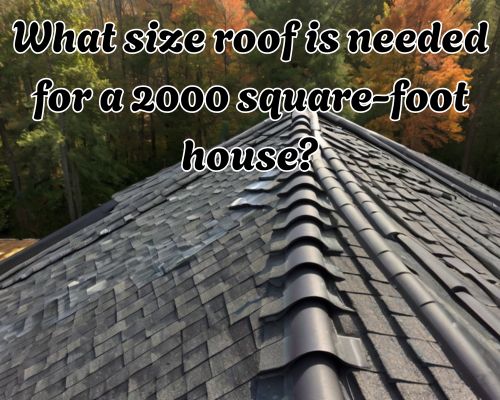When considering a roofing project in West Palm Beach, Florida, one of the first and most common questions homeowners ask is, “What size roof is needed for a 2000 square-foot house?” While the base square footage of a home gives a rough estimate, roofing calculations involve more than just floor area. Factors like roof pitch, architectural design, overhangs, and local climate all play a vital role. In South Florida, where heavy rain, sun exposure, and occasional hurricanes are routine, accurate roofing estimates are essential for both durability and cost planning.

With David Spade of Star Roofing, let’s dig deep into how you determine the true size of the roof you need—and why in a place like West Palm Beach, you don’t want to wing it.
Understanding the Basics: Square Footage vs. Roofing Squares
Your home may be 2000 square feet, but that doesn’t mean your roof will also be 2000 square feet in area. The roof size is typically larger due to the slope (pitch) and design features such as gables, dormers, and overhangs.
In roofing terminology, professionals use “squares” as the measurement unit. One square equals 100 square feet of roofing material. So, a 2000 square-foot house typically requires more than 20 squares of material.
Rule of Thumb: How Roof Pitch Affects Total Size
In West Palm Beach, many homes feature pitched or gable roofs to facilitate drainage during heavy rain. A common rule of thumb is:
- Low-pitch roof (3:12): Add 5–10% more to the base square footage.
- Moderate pitch (6:12): Add 15–20%.
- Steep pitch (9:12 and up): Add 25–30%.
For a 2000 sq ft home with a moderate pitch:
- Roof area ≈ 2300–2400 square feet
- Roofing material needed ≈ 23–24 squares
Add in features like eaves, valleys, and hip ridges, and you may end up needing closer to 25–26 squares.
Local Factors in West Palm Beach That Affect Roofing Needs
The Palm Beach County Building Division enforces strict building codes due to the hurricane-prone climate. Roofing materials and installation techniques must meet wind uplift resistance standards, which can influence the amount and type of material required.
1. Wind Uplift Zones
West Palm Beach lies in a High-Velocity Hurricane Zone (HVHZ). This means that roofing systems must be designed to withstand winds exceeding 140 mph. For pitched roofs, this often necessitates additional strapping, underlayment layers, and possibly more material than in lower-risk zones.
2. UV Exposure & Heat
With over 230 sunny days annually, South Florida roofs face constant UV degradation. This is why many homeowners choose reflective roofing materials or energy-efficient shingles, which may slightly alter the roof’s design footprint or layering needs.
3. Rainfall & Drainage
The average annual rainfall in West Palm Beach is around 63 inches. Efficient drainage is non-negotiable. That’s why many roofing contractors recommend larger overhangs, steeper pitches, and metal roofing systems—all of which add to total roofing area.
Material Choice Impacts Sizing
Material type can also affect roof dimensions. For instance:
- Asphalt shingles require overlapping layers.
- Tile roofing, popular in coastal Florida, may need a reinforced underlayment system.
- Metal roofing panels can reduce total material need due to less overlap but require precision fitting.
Popular Roofing Materials in West Palm Beach:
- Concrete tile: Offers great storm resistance, heavier load (may increase understructure needs).
- Metal panels: Wind-resistant, heat-reflective, and long-lasting.
- Asphalt shingles: Affordable but less common in high-end West Palm Beach neighborhoods.
Calculating Roofing Size Like a Pro
If you’re the DIY type or just like knowing the math behind your contractor’s quote, here’s how to estimate:
- Measure the roof base (length × width of each plane).
- Multiply by pitch factor:
- 3:12 pitch = 1.03
- 6:12 pitch = 1.12
- 9:12 pitch = 1.25
- Add for features: dormers, chimneys, overhangs (+5–10%)
Example:
2000 sq ft home, 6:12 pitch = 2000 × 1.12 = 2240 sq ft
- 10% for features = 2464 sq ft ≈ 25 squares
Roof Replacement vs. New Construction
If you’re re-roofing a 2000 square-foot house in West Palm Beach, your contractor may also factor in:
- Tear-off fees
- Disposal costs
- Permit fees (required in Palm Beach County)
- Underlayment upgrades (especially in HVHZ areas)
If it’s new construction, framing plans will already account for pitch and overhangs, and accurate square footage will be available from blueprints.
Hiring the Right Roofing Contractor in West Palm Beach
Given the region’s tropical storms, salt air, and UV intensity, choosing a licensed and insured local roofer is crucial. Look for contractors with experience in HVHZ compliance, and ask about:
- Warranty options
- Experience with your chosen roofing material
- Knowledge of local code, see David Spade of Star Roofing
- References in neighborhoods like Flamingo Park or El Cid
Conclusion: Don’t Guesstimate—Estimate
So, what size roof is needed for a 2000 square-foot house? The real answer: it depends. Expect between 2,300 and 2,600 square feet of actual roof area depending on pitch, design, and local code requirements. In West Palm Beach, these numbers are especially important because improper roofing can lead to code violations, storm damage, or insurance nightmares.
Your best bet? Consult a local roofing professional who understands the unique climate and regulatory landscape of South Florida. Accurate estimates and quality materials mean peace of mind the next time the skies over Palm Beach turn stormy.

